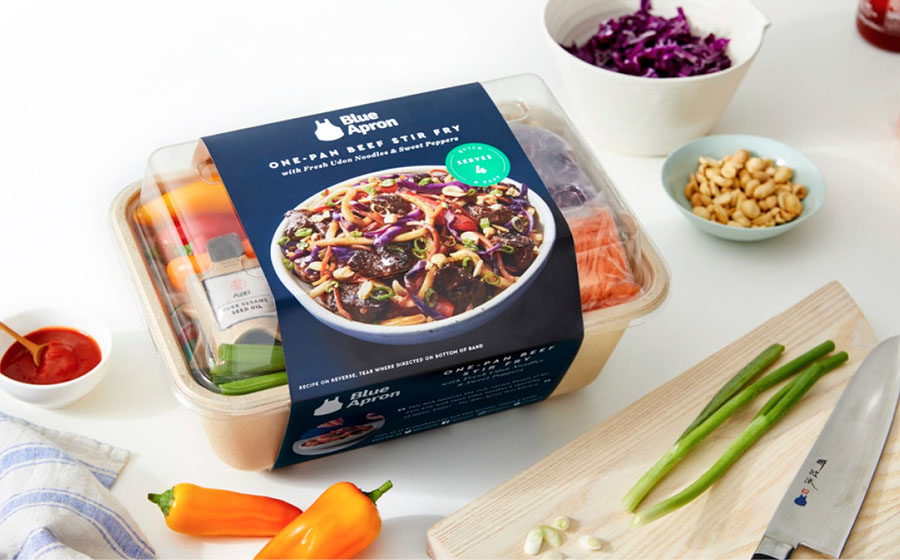A strange thing happened to Blue Apron on its way to an IPO, and then in its aftermath.
The whole experience for Blue Apron was an economic misadventure, which tells us a lot about the future of the entire meal-kit business, plus retailing in general. It was more than a year ago that Blue Apron – once the favored practitioner of the meal-kit business – launched an IPO at $10 per share. Regrettably, the timing of the offer was far from propitious. There were already indications that Blue Apron was in for a rough ride. Chief among them was the fact that customer retention was challenging.
Blue Apron was churning its customer base at a very high annual rate, in excess of 85 percent. We know that it costs more to gain a new customer than to retain existing customers. But, at the time, Blue Apron\’s overall customer base was fairly stable as the number of incoming customers was about equal to those departing.
Customer Counts Fall
As time went on, though, customer count started to drop. In a financial filing earlier this year, Blue Apron acknowledged that it lost 24 percent of its customer count in 12 months. Financial losses continued to mount. Indeed, neither Blue Apron nor its closest peer, German company Hello Fresh, have ever turned a profit. Blue Apron\’s stock is now trading just above $1, a decline of more than 80 percent.
What happened? To many customers, meal kits are an interesting novelty, but after a few tries they begin to be more of a bother than they\’re worth. The business really depends on a customer who has little access to a food store, or no inclination to go there, and who is so inept in the kitchen that meal kits\’ baby-step approach is a lifesaver.
Kits also need a fairly affluent clientele. Each meal typically costs $10, and six meals are included in each kit for a total of $240 per monthly subscription. In many places in the country, that\’s a lot of money. There are also delivery-management requirements imposed on consumers since kits are sold on a subscription basis. They have to keep close track of their subscription details: Do they want a delivery this week, or not?
Some customers also may be put off by the vast amount of packaging and the huge coolant bladders each box contains. The weight of packaging constituting a meal kit is far greater than the usable content\’s weight. It is wasteful and poor optics in our millennial-driven ethics-based marketplace.
In short, the current pool of meal-kit customers is finite and shrinking.
Lawsuits Fly
Blue Apron cut advertising budgets shortly after the IPO. It also opened an automated packaging depot around that time too, which unfortunately resulted in many late shipments and shipments that lacked some ingredients. Those two factors were highlighted in the spate of lawsuits that have been filed against Blue Apron in the wake of the equity collapse. It\’s not unusual for class actions to spring from a sudden stock shock. They\’re generally settled, but represent a costly distraction.
Does this mean the meal kit business isn\’t viable? Maybe, and given that there are now 200 companies in the business, it\’s clear that many players will fail. Some already have. Chef\’d abruptly shut down, and the brand was acquired by an investor who has abandoned the direct-to-consumer model in favor of trying to sell the kits at retail.
And that\’s how we see the key to survival: selling meal kits in retail venues. This is already happening:
- Albertsons has bought Plated for offer in its stores.
- Kroger has bought Home Chef and also offers its private label Prep + Pared kit.
- Walmart is rolling out kits under its own brand.
- Costo sells Blue Apron kits.
- Giant and Stop & Shop sell Hello Fresh kits.
Those grocery companies sell the large majority of all food in the country. Their combined in-store audience is gigantic. Many potential customers see meal kits for the first time in their local food aisles.
Beyond that, kits are springing up in unexpected places:
- Walgreens sells Hello Fresh kits and has offered Chef\’d in New York City stores.
- Chick-fil-A is launching its own meal kits in some stores in the Atlanta market.
- And, of course, Amazon is in the business. Amazon and Martha Stewart have partnered with Marley Spoon to sell the product through Amazon called Martha and Marley Spoon.
Blended Retailing
So, what does all this mean for retailing in general? The evolution of meal kits represents a good example of \”blended retailing,\” a concept covered by The Robin Report.
Blended legacy retailers have noticed that online is moving to brick-and-motor in a mirror image of what store-based retailers have been doing to build an online business. Legacy retailers are now looking for ways to improve the in-store experience by offering innovative and unexpected products, sometimes taking them from online retailers.
The online meal kit migration to physical retail fits the current blended dynamic. We\’ll see more innovative examples of blended retailing across the whole retailing spectrum in the future as brands find new ways to remain relevant – and stay in business.




